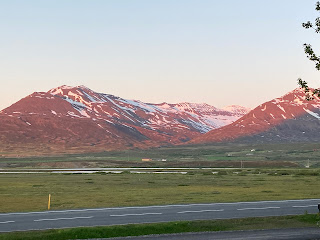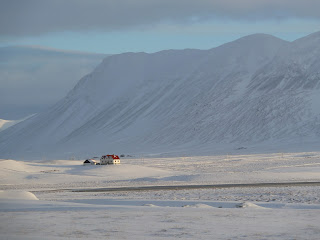Summer and Autumn in Iceland
Nordic countries are often depicted as being dark, gloomy and depressing. But that is only half the story. The other half is summer, when the sun shines for twenty-one hours – the photo above was taken in Dalvík at midnight. It is light at 11 p.m. in Reykjavík on a Saturday night when the crowds are going into the bars and it is light at 2 a.m. when they are leaving. It is an extraordinary sight to see so many drunk people so early in the morning.
Icelanders become manic. Their eyes sparkle bright blue, but there are red rims around them. On the farms, if winter was the time of snoozing, summer was the time of eighteen-hour days. A whole year’s farming had to be crammed into a few short months. In particular, the hay had to be harvested to feed the livestock over the winter.
Today Icelanders are still busy eighteen hours a day in summer. Eight o’clock in the evening feels like mid-afternoon. It can be difficult trying to go to sleep at ten thirty when your body is telling you it is early evening.
Then comes autumn. Despite the lack of trees, there are autumn colours in Iceland. Various berries and dwarf willows and birches change colour, and the lava fields and heathlands glow in purples and oranges.
Then comes autumn. Despite the lack of trees, there are autumn colours in Iceland. Various berries and dwarf willows and birches change colour, and the lava fields and heathlands glow in purples and oranges.
Autumn is also the time of the réttir, the annual round-up, when the members of a farming community get on their horses and spend three days scouring the mountains with their sheepdogs rounding up their sheep. The beasts are brought down to pens, sorted by the farmers, and put in barns for the winter. The farmers and their children get very excited at seeing their sheep again, all of whom have their own names, and a good time is had by all. I have no idea what the sheep think about it. I once wrote a short story called The Super Recogniser of Vík about a farmer who was expert at recognizing sheep and was dragged to Reykjavík by Magnus to look at CCTV to find a burglar.
So when is the best time to come to Iceland? Most people come in July and August: these are the two warmest months, and of course children are on school holiday. Personally, I avoid these two months. I’d rather spend the summer months somewhere where the temperature exceeds 20 °C.
So when is the best time to come to Iceland? Most people come in July and August: these are the two warmest months, and of course children are on school holiday. Personally, I avoid these two months. I’d rather spend the summer months somewhere where the temperature exceeds 20 °C.
More importantly, Iceland is crowded. Tourist numbers are rocketing: from only a few hundred thousand at the time of the kreppa in 2009 to over two million a year now. Despite a construction frenzy in Reykjavík, the infrastructure can’t keep up. It’s hard for locals to rent accommodation in Reykjavík because most apartments coming on the market are rented out on Airbnb. More worryingly, there are not enough public toilets, especially out in the countryside. This infrastructure is at its most overstretched in July and August.
The Icelandic landscape is much more delicate than it looks; hordes of tourists’ walking boots can wreak havoc on moss and lichens trying to establish themselves on new lava. The paradox of travelling a thousand miles to a desolate spot to enjoy the isolation is highlighted when dozens of others are doing the same thing. Summer is also the time when volunteer search-and-rescue teams become fed up with rescuing tourists who have wandered into the wrong place at the wrong time.
I see I have mentioned the idiotic acts of tourists a number of times in this blog. It’s not that all tourists are stupid - clearly, most are not - but the moronic minority gives the rest of us a bad reputation with the locals.
So I would visit in the slightly quieter months of May and June, or September to November. In September the grass is still green, the snow has yet to fall and it’s beginning to be possible to see the Northern Lights. In November, you can experience winter and yet still enjoy a little daylight. Go expecting bad weather; that way you won’t be disappointed.
The Icelandic landscape is much more delicate than it looks; hordes of tourists’ walking boots can wreak havoc on moss and lichens trying to establish themselves on new lava. The paradox of travelling a thousand miles to a desolate spot to enjoy the isolation is highlighted when dozens of others are doing the same thing. Summer is also the time when volunteer search-and-rescue teams become fed up with rescuing tourists who have wandered into the wrong place at the wrong time.
I see I have mentioned the idiotic acts of tourists a number of times in this blog. It’s not that all tourists are stupid - clearly, most are not - but the moronic minority gives the rest of us a bad reputation with the locals.
So I would visit in the slightly quieter months of May and June, or September to November. In September the grass is still green, the snow has yet to fall and it’s beginning to be possible to see the Northern Lights. In November, you can experience winter and yet still enjoy a little daylight. Go expecting bad weather; that way you won’t be disappointed.
I have a trip planned myself in the first week of October this year – I'm really looking forward to it. It will be nearly two years since I last visited Iceland.
If you would like to receive a free copy of my 60-page novella The Polar Bear Killing and occasional emails about my books, sign up here.




Great advice, Michael. Thank you!
ReplyDelete